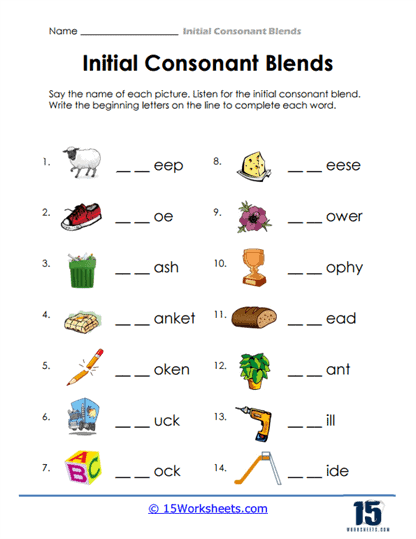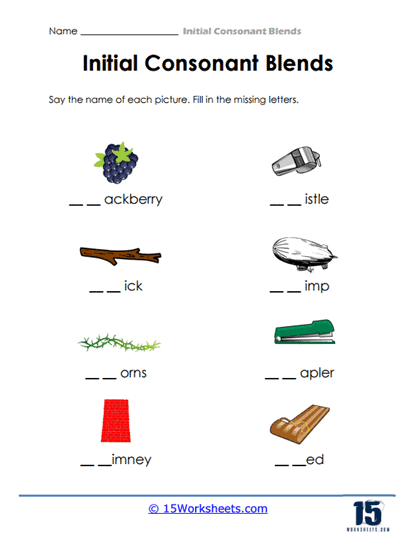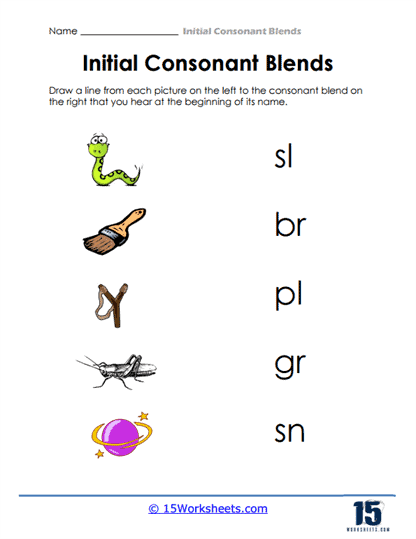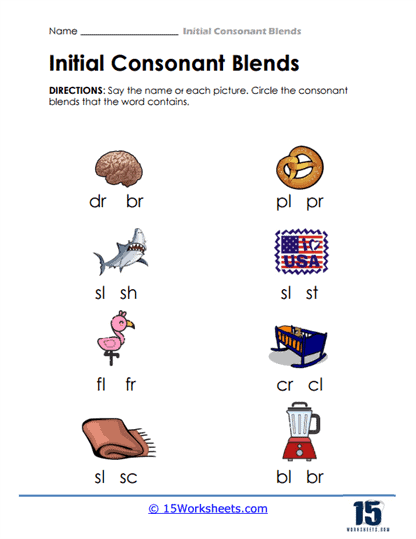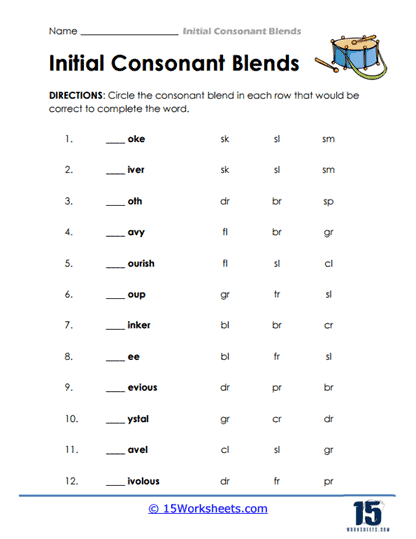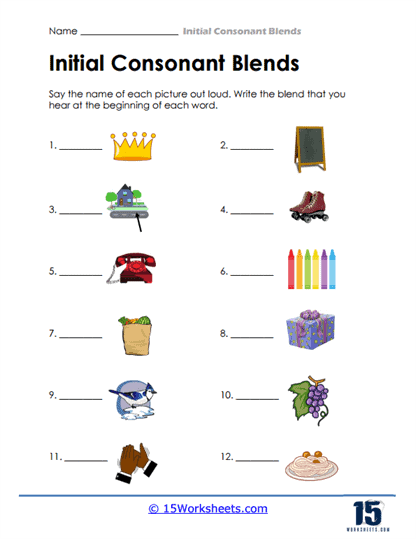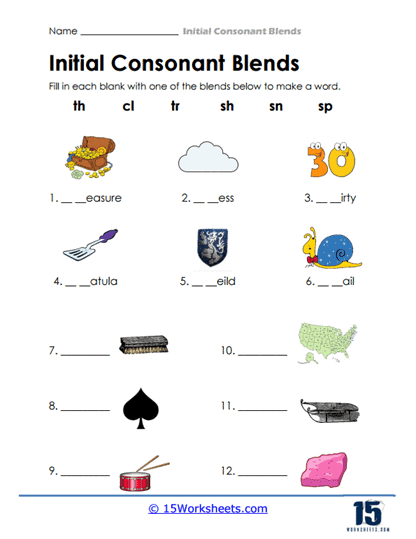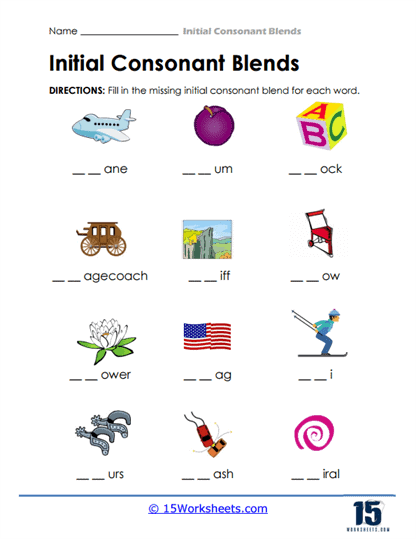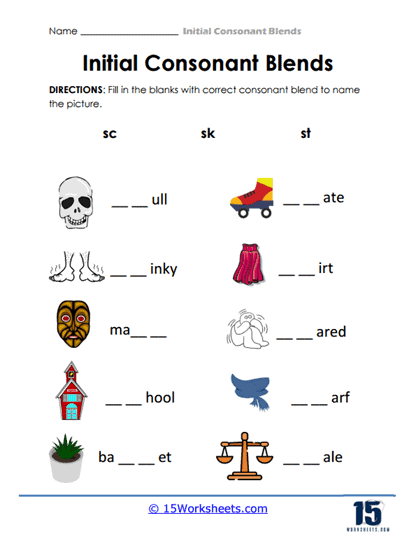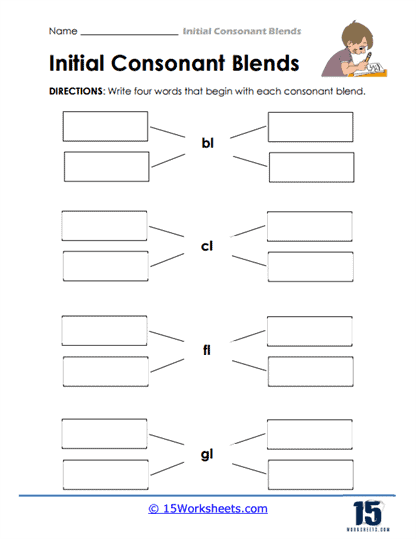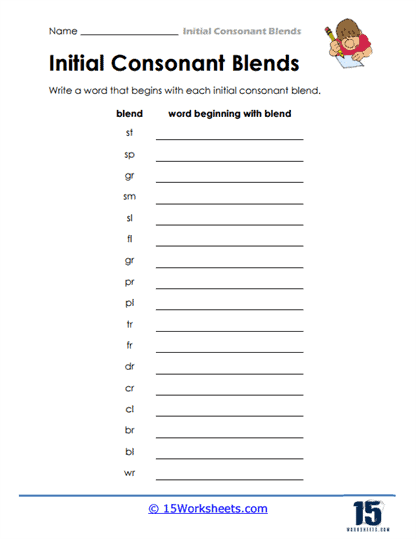Initial Consonant Blends Worksheets
All About These 15 Worksheets
These worksheets are a fantastic resource for students, teachers, homeschoolers, and tutors to help young learners build foundational literacy skills, specifically in phonics. These worksheets focus on teaching students how to combine two or more consonants at the beginning of a word to form a blend. Consonant blends are when two or more consonants are pronounced in sequence, with each sound retaining its individual identity. Common examples of initial consonant blends include “bl,” “st,” “dr,” and “cl.” Mastering these blends is essential for developing reading fluency, spelling skills, and overall language proficiency.
For students, these worksheets offer an engaging way to practice recognizing and pronouncing different consonant combinations. They provide visual cues, such as pictures, to help associate sounds with words, which is particularly helpful for early readers who are still developing phonemic awareness. Teachers and homeschoolers find these worksheets invaluable because they provide structured exercises that can be used as part of a lesson or as independent practice. Tutors can also use these worksheets to target specific areas where a student might need extra help, reinforcing the blending skills needed for reading success.
Variety of Exercises
Initial consonant blends worksheets typically offer a wide range of exercises to reinforce learning in different ways. Based on the series of images provided, I can highlight some common types of exercises that would likely appear throughout the collection:
Fill-in-the-Blank Exercises – Many worksheets ask students to complete words by filling in the correct consonant blend. For example, in one of the images, students must fill in the blank spaces with the correct blends (like “fr,” “st,” or “cr”) to complete the word matching a picture, such as “frog,” “strawberry,” and “spoon.” These tasks help students practice identifying which blend correctly completes the word based on visual clues.
Multiple Choice and Circle the Correct Blend – Another common exercise requires students to choose the correct consonant blend from a list. For instance, students might see an image of a tree and be asked to circle the blend “tr” from options such as “br” or “dr.” This exercise helps solidify recognition of consonant blends in context, combining both visual recognition and auditory memory.
Picture and Word Association – Several worksheets encourage students to name objects depicted in images and identify the correct consonant blend based on the sound they hear at the beginning of the word. For example, an image of a truck might prompt a student to write or circle the initial “tr” blend. This kind of exercise is excellent for developing auditory discrimination and linking sounds with written symbols.
Word Completion by Listening – Some exercises direct students to complete words by listening to and identifying the initial consonant blend. For example, students are shown pictures of objects and must listen carefully to the beginning sound, then write the corresponding blend, such as “cr” for “crab” or “sn” for “snail.” This approach is perfect for auditory learners and helps strengthen listening skills.
Consonant Blend Word Lists – A few worksheets focus on creating word lists. Students might be asked to think of multiple words that start with a given consonant blend (such as “bl,” “fl,” “sl”) and write them down. This kind of open-ended activity encourages vocabulary building and creative thinking as students try to generate words independently.
Blends in Context (Story-Based or Full Sentence Completion) – While this might not be evident from the images, another common type of exercise often found in these worksheets involves placing words with blends into sentences or short stories. This activity helps students understand how these words function in a broader context, further enhancing their reading comprehension.
What are Initial Consonant Blends?
Initial consonant blends are a key component of phonics, the system by which sounds are connected to letters and used to teach reading and writing. In simple terms, an initial consonant blend occurs when two or more consonants are grouped together at the beginning of a word, and each consonant retains its individual sound. Unlike digraphs, where two consonants combine to make one sound (such as “ch” in “chair”), in a consonant blend, both sounds are heard. For example, in the word “black,” the “b” and “l” sounds blend together, but each sound is still distinct. Mastering these blends is essential for students as they develop reading fluency and decoding skills.
Initial consonant blends are important because they form the building blocks of many common words in English. By learning to recognize and pronounce these blends, students improve their ability to decode unfamiliar words. This is especially critical during the early stages of reading instruction, as many simple, high-frequency words contain consonant blends. Understanding how these sounds work together helps students not only in reading but also in spelling, as they begin to recognize patterns in words. Phonics instruction that includes consonant blends prepares students to tackle increasingly complex words as they progress in their reading journey.
Phonemic awareness is the ability to hear, identify, and manipulate individual sounds (phonemes) in spoken words. Initial consonant blends contribute to the development of this awareness. When students learn consonant blends, they become more attuned to the subtle differences between sounds, which is an important skill for literacy. For instance, recognizing the difference between “bl” in “blue” and “br” in “brown” requires careful listening and pronunciation. This practice enhances students’ ability to break down words into smaller sound units, which they can then recombine to form words, improving both reading and speaking abilities.
Reading fluency is the ability to read with speed, accuracy, and proper expression. Initial consonant blends play a significant role in achieving this fluency. When students can quickly identify and pronounce blends like “fl,” “cl,” or “gr,” they are able to read smoothly without stumbling over individual sounds. Fluent reading is crucial for comprehension because it allows students to focus on understanding the text, rather than getting bogged down by decoding each word. The quicker students can recognize consonant blends, the more naturally they can move through sentences and paragraphs, leading to improved overall reading comprehension.
One of the ultimate goals of phonics instruction is to help students become independent readers. Initial consonant blends support this by giving students the tools to decode unfamiliar words on their own. Once students learn common blends, they can apply this knowledge to new words they encounter, breaking down the word into manageable parts and sounding it out. For example, a student who knows the “st” blend can approach a word like “stop” or “stair” with confidence. This skill promotes a sense of independence and empowers students to tackle reading challenges with less reliance on teacher guidance or memorization.
Examples of Initial Consonant Blends
“Bl” in “Black” – In this blend, the “b” and “l” sounds combine at the beginning of the word. Both sounds are distinct but blended smoothly when spoken.
“Cr” in “Crown” – In this case, the “c” and “r” sounds are pronounced together, with each sound retaining its individuality, creating a blend that forms the start of the word “crown.”
“Fl” in “Flower” – In this blend, the “f” and “l” sounds combine at the beginning of the word. Both sounds are distinct but blend smoothly to form the word “flower.”
“Gr” in “Green” – The “g” and “r” sounds are blended at the start of the word “green,” with each sound retaining its uniqueness but flowing together in pronunciation.
“Pl” in “Plane” – In this blend, the “p” and “l” sounds are pronounced together at the start of “plane,” combining smoothly while each sound remains clear.
“Sn” in “Snake” – Here, the “s” and “n” sounds blend together at the beginning of “snake,” creating a smooth, combined sound while keeping each consonant distinct.
“Tr” in “Tree” – The “t” and “r” sounds blend at the start of “tree,” allowing each sound to be heard individually while forming a unified initial blend.




